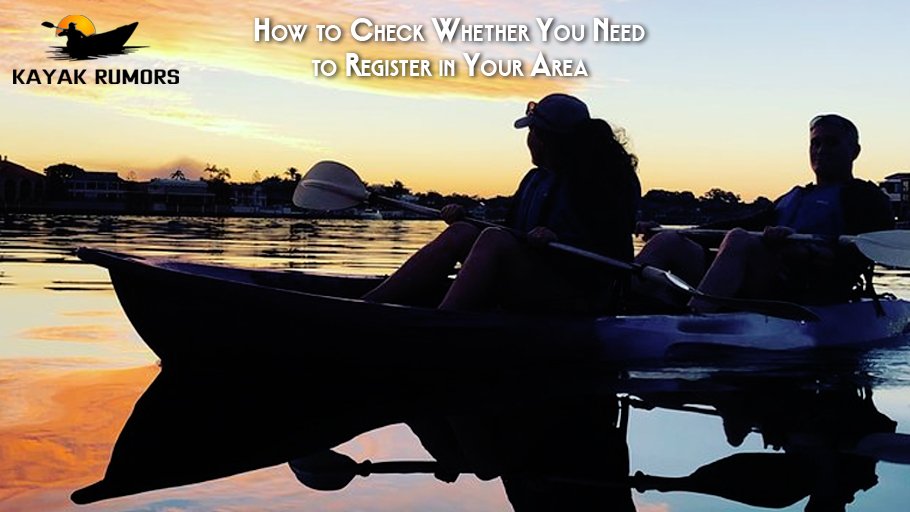Paddling out on your kayak can be peaceful — but before you hit the water, one question often pops up: do you have to register a kayak? The answer isn’t always “yes” or “no.” It depends on where you live, what kind of kayak you have, and how you use it. In this guide, I’ll walk you through which kayaks must be registered, how to find your local rules, the registration process, and tips to stay legal (and safe) on the water.
If you’re searching for “kayak registration,” “register a kayak,” “kayak license requirement,” or “do kayaks need registration,” you’ll find the insights you need right here. Let’s dive in.
1. What “Register a Kayak” Really Means
Before we explore if you must register, it helps to know what registration entails.
When someone asks, “Do you have to register a kayak?” they’re asking whether a government agency (state, province, or local) requires your kayak to carry a registration number, boat decals, or documented ownership. It’s similar to how cars have license plates, though generally much simpler for vessels.
Registration usually involves:
- Providing proof of ownership (bill of sale, manufacturer paperwork)
- Declaring the kayak’s specifications (length, make, hull ID number)
- Paying a registration fee (often small)
- Displaying a registration decal or number on the hull
Note: Smaller, non-motorized kayaks often fall under exemptions, but every jurisdiction’s rules differ.
2. When You Do Not Need to Register a Kayak
Many kayaks do not require registration, and for good reason. Here are common exemptions and scenarios where registration is unnecessary.
Non-Motorized Kayaks Are Often Exempt
If your kayak is propelled purely by paddle (or pedal) and does not have a motor or sail, many states, provinces, or regions will exempt it from registration. In these cases, you can paddle legally without needing a hull number or sticker.
Private Waters & Non-Public Launches
If you only use your kayak on private lakes, ponds, or waterways not part of public systems, registration is often not required. Local rules may still apply, but public agencies usually don’t enforce registration in private settings.
Short or Temporary Use
Some places waive registration for short-term or occasional use. If you take your kayak into a region where registration is required, but only temporarily (e.g., visiting), some agencies allow temporary permits instead of full registration.
Certain Sizes or Features Below Threshold
Some jurisdictions set size limits (for example, kayaks under a certain length) for registration. If your kayak is short or lacks certain features (like a motor), it might fall under “no registration required” (for example, under 10 ft, or without sail or motor).
3. When You Do Have to Register a Kayak
Now let’s flip to when registration is required.
Motorized Kayaks
If your kayak has any kind of motor (electric, gas, trolling motor), many authorities treat it like a small boat. That often triggers mandatory registration, regardless of how big the motor is.
Commercial Use, Rentals, Guided Tours
If you use your kayak for business — guiding, rental, or tours — you’ll likely need to register it. Commercial use often removes exemptions that typical recreational paddlers enjoy.
Usage in Regulated Public Waters
In some states or provinces, kayaks must be registered to be launched from public boat ramps or used in certain rivers, lakes, or protected waterways. Even non-motorized kayaks may require registration or permits in those cases.
Crossing Jurisdictions or Traveling
If you transport your kayak across borders (state to state or country to country), you may need to register or carry legal documentation depending on local laws along your route.
4. How to Check Whether You Need to Register in Your Area

Because rules vary so much, the best path is to check local regulations. Here’s how:
A. Start with State or Provincial Boating Agencies
Search for your state’s Department of Natural Resources (DNR), Department of Fish and Wildlife, or boating agency. Many publish “boat registration” details online.
B. Look for “Paddlecraft Registration” or “Non-Motorized Vessel Regulation”
Don’t just look under “boats.” Sometimes kayaks are categorized under paddlecraft or non-motorized vessels. Use those search phrases.
C. Ask Local Offices or Boating Shops
Call your county or city boating office, marina, or paddling shop. They often know local laws or can point you in the right direction.
D. Check for Registration in Neighboring Areas
Sometimes laws differ by county or water district. Even within a state, two lakes might have different requirements. Don’t assume it’s uniform everywhere.
5. How to Register a Kayak: Step‑by‑Step Process
If registration is required, here’s what most people will have to do.
Step 1: Gather Required Documents
- Proof of ownership (bill of sale, manufacturer certificate)
- Hull Identification Number (HIN) or serial number (if available)
- Details of kayak: make, model, length, material
Step 2: Fill Out Application
You’ll usually complete a registration form provided by the boating agency or DMV. Some areas allow online registration; others require in‑person or mail.
Step 3: Pay Fees
Fees vary widely. You might pay a small annual or biennial fee. In some places, it’s just a token cost.
Step 4: Receive and Attach Registration / Decals
Once approved, you may receive a small decal or number that you must affix to the kayak hull, often on the bow (front). The registration paperwork should stay with you or the kayak.
Step 5: Renew as Required
Some regions need you to renew registration annually or every few years. Watch for expiration dates and reminders.
6. Benefits & Risks: Why Register (Even If Not Mandatory)
Even when registration isn’t strictly required, there are good reasons to consider it.
Proof of Ownership & Theft Recovery
Registration gives you documented ownership, which helps if your kayak is lost or stolen. You can more easily prove it belongs to you.
Access to Certain Waterways & Launch Sites
Some lakes, rivers, or public ramps require registered vessels. Without registration, you may be denied access.
Legal Compliance
Registering avoids fines, penalties, or impoundment in jurisdictions that enforce registration laws. It’s better to be safe, especially if rules change.
Community & Conservation Support
Fees from boat registration often help maintain waterways, docks, ramps, and conservation programs. Your registration contributes to infrastructure and habitat preservation.
7. FAQs About Do You Have to Register a Kayak
Q1: Do I need a license for my kayak?
Usually, for non-motorized, recreational use, most places don’t issue a kayak “license.” They may require registration or permits, but not a license like driving.
Q2: Where is the hull ID or serial number on a kayak?
Often near the stern (back) underside, molded into plastic, or on a sticker. If you can’t find one, some agencies can issue a replacement or inspection number.
Q3: What if I bought a used kayak with no paperwork?
You may use a bill of sale, signed statement, or purchase receipt to support registration. Some places do inspections and assign a new number if needed.
Q4: Do I need registration if I only kayak occasionally?
It depends on local law. Some authorities exempt infrequent or recreational use. Check your area’s rules—some allow use without registration in many cases.
Q5: Can I paddle across state lines with a non-registered kayak?
Often yes, especially if non-motorized. But crossing state lines might require you to comply with the stricter rules of the state where you paddle. Always check destination rules before you go.
Need Local Rules? Check Your State’s Kayak Registration Page
Kayak registration rules vary by location. Some states require all kayaks to be registered—others only if they’re motorized. To stay legal, always check directly with your state’s boating agency.
👉 Find Your State’s Registration Info
8. Final Thoughts & Practical Steps You Can Take Today
So, do you have to register a kayak? Sometimes. It depends on what kind of kayak you have, how you use it (motorized vs paddle), and where you’re paddling.
Here’s what you can do now:
- Find your local boating agency and read their registration rules.
- If your kayak is motorized or used commercially, plan to register it.
- Gather proof of ownership and any serial/HIN numbers.
- Consider registering voluntarily even if not required — it gives you benefits.



